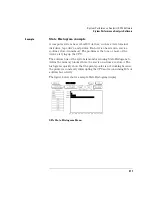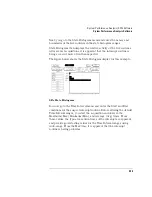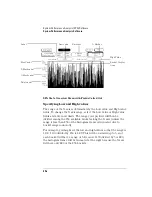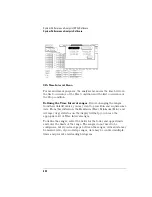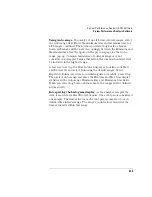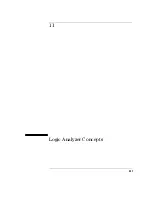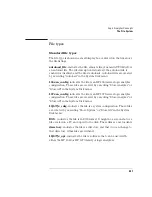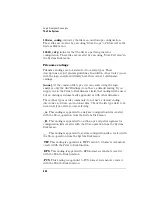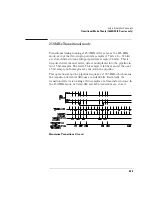
390
System Performance Analysis (SPA) Software
System Performance Analysis Software
Interpreting the histogram display.
Press the blue shift key and
Run to start the State Histogram acquisition. The relative activity over
the ranges you defined is displayed as histograms (see the figure on the
previous page). The total samples field shows the total number of data
samples displayed in all of the ranges. The number of samples for each
range is displayed to the left of each histogram.
The percentage amounts of the histograms total 100% (note the scale
at the bottom of the display). If they add up to more than 100%, you
have overlapped two or more ranges, and the data samples are being
counted in multiple ranges.
The analyzer will continue to sample, sort the data, and update the
display until you press Stop or change a display variable.
Other States included/excluded.
The histograms show the relative
distribution of activity over the ranges you have defined. In most cases,
the ranges will not cover the full range of the label you chose to
monitor.
To view the activity over the entire range of the label, including activity
not covered by the ranges, select the Other States field and change it to
included. Another histogram bar called "other" will appear at the
bottom of the display. This will show activity not covered by the ranges.
You can toggle included/excluded if the analyzer is stopped or if it is
running because it only affects the display and not the accumulated
data that has been acquired.
Note that changing between included and excluded changes the
absolute sizes of the histograms. Unless you have defined overlapping
ranges, the total percentage size of the all the range histograms plus
the histogram for other should equal 100%.
Summary of Contents for 1670E Series
Page 6: ...6 In This Book...
Page 26: ...26 Contents...
Page 27: ...27 Section 1 Logic Analyzer...
Page 28: ...28...
Page 29: ...29 1 Logic Analyzer Overview...
Page 39: ...39 2 Connecting Peripherals...
Page 49: ...49 3 Using the Logic Analyzer...
Page 72: ...72 Using the Logic Analyzer The Inverse Assembler...
Page 73: ...73 4 Using the Trigger Menu...
Page 101: ...101 5 Using the Oscilloscope...
Page 151: ...151 6 Using the Pattern Generator...
Page 199: ...199 7 Triggering Examples...
Page 237: ...237 8 File Management...
Page 249: ...249 9 Logic Analyzer Reference...
Page 360: ...360 Logic Analyzer Reference The Compare Menu...
Page 361: ...361 10 System Performance Analysis SPA Software...
Page 397: ...397 11 Logic Analyzer Concepts...
Page 430: ...430 Logic Analyzer Concepts The Analyzer Hardware Oscilloscope board theory Oscilloscope board...
Page 439: ...439 12 Troubleshooting the Logic Analyzer...
Page 455: ...455 13 Specifications...
Page 471: ...471 14 Operator s Service...
Page 479: ...479 Operator s Service Troubleshooting Troubleshooting Flowchart 2...
Page 491: ...491 Section 2 LAN...
Page 492: ...492...
Page 493: ...493 15 Introducing the LAN Interface...
Page 497: ...497 16 Connecting and Configuring the LAN...
Page 506: ...506 Connecting and Configuring the LAN Connecting and Configuring the LAN...
Page 507: ...507 17 Accessing the Logic Analyzer File System Using the LAN...
Page 515: ...515 18 Using the LAN s X Window Interface...
Page 527: ...527 19 Retrieving and Restoring Data Using the LAN...
Page 539: ...539 20 Programming the Logic Analyzer Using the LAN...
Page 546: ...546 Programming the Logic Analyzer Using the LAN Programming the Logic Analyzer Using the LAN...
Page 547: ...547 21 LAN Concepts...
Page 555: ...555 22 Troubleshooting the LAN Connection...
Page 580: ...580 Troubleshooting the LAN Connection Getting Service Support...
Page 581: ...581 Section 3 Symbol Utility...
Page 582: ...582...
Page 583: ...583 23 Symbol Utility Introduction...
Page 588: ...588 Symbol Utility Introduction Symbol Utility Introduction...
Page 589: ...589 24 Getting Started with the Symbol Utility...
Page 597: ...597 25 Using the Symbol Utility...
Page 609: ...609 26 Symbol Utility Features and Functions...


